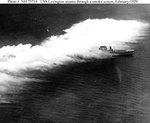Conslaw
Senior Airman
I was browsing through Lundstrom's The First Team, Pearl Harbor to Midway, and he he makes brief mention of a strike launched December 7, 1941 by the Enterprise that failed to find the Japanese fleet. This particular strike featured 6 SBDs of VB6 escorting TBDs. The interesting thing is that these SBDs were "smokers" - that is - they had underwing smoke generators intended to screen the approach of the slow torpedo bombers. I've never seen any other mention of this tactic. If anyone else knows more, please post.
I can see how it might be useful, though smoke might make it as hard for the torpedo planes to line up on their target as it is for the ships to see the planes to shoot them. Actually it seems more useful to me to have the TBDs carry the smoke generators, especially when lining up an "anvil" attack fro two sides. The first TBDs to the target could lay smoke, making the people on the ship worry about what's coming in behind the planes they can see. In the meantime, non-smokers on the other side are coming in with less attention.
I can see how it might be useful, though smoke might make it as hard for the torpedo planes to line up on their target as it is for the ships to see the planes to shoot them. Actually it seems more useful to me to have the TBDs carry the smoke generators, especially when lining up an "anvil" attack fro two sides. The first TBDs to the target could lay smoke, making the people on the ship worry about what's coming in behind the planes they can see. In the meantime, non-smokers on the other side are coming in with less attention.

